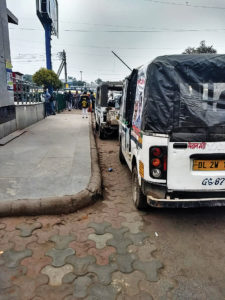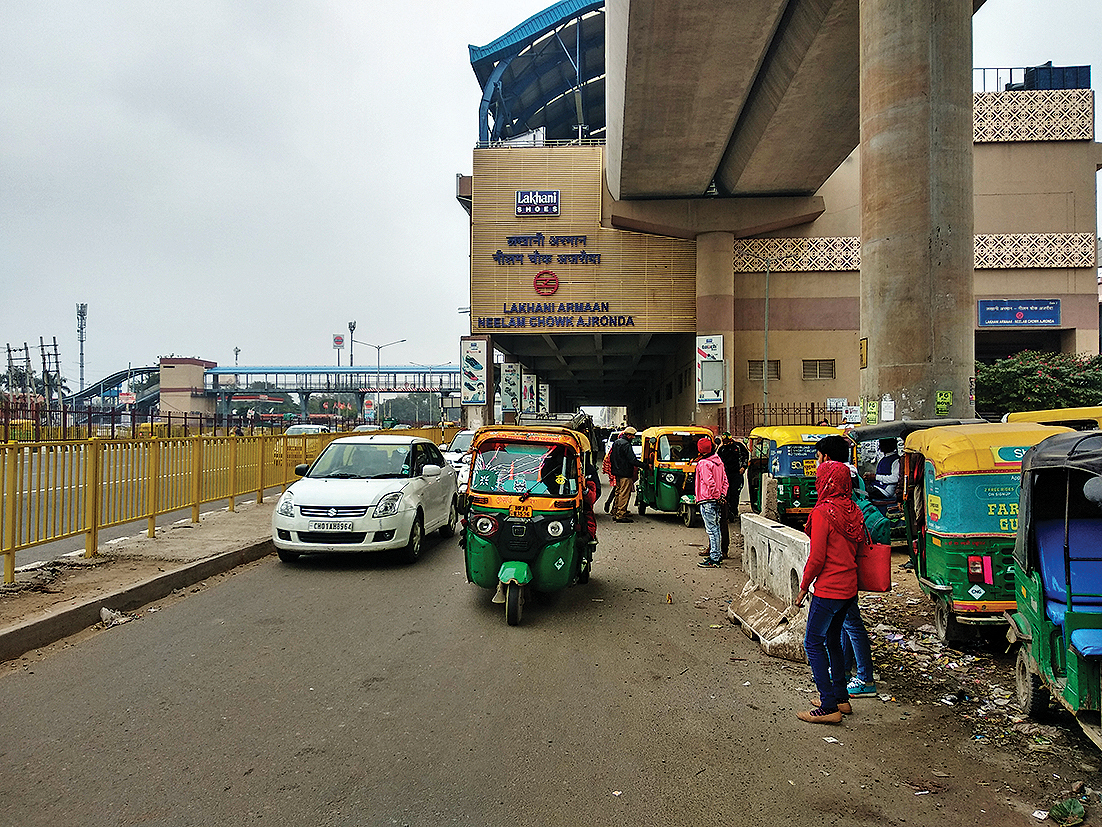In the absence of last mile connectivity to the Metro, commuters from Faridabad, Noida and Gurugram face a number of hurdles
Every day, around 10 am, Aditya Sharma, 27, a sales and marketing professional, is ready to leave his home in Faridabad for office. When he reaches the main road, he waves to the passing autos, but sometimes doesn’t get a single one to stop.
He tries his luck by crossing the road, where a shared auto stops. He boards this one to reach another spot a kilometre away. Here again, he has to wait for another auto which will take him to Neelam Chowk Ajronda Metro station, from where he will board the train to his Janpath office.
The Delhi Metro network is one of the most efficient in the world with a daily ridership of 28 lakh. The network is expanding further into Haryana, with an extension to Sonepat via Bawana, Narela and Kundli Industrial Area. Construction is expected to begin in April. However, last mile connectivity is not keeping pace with the expansion.
Faridabad doesn’t have a city bus service, which is why all this hop, skip and jump. No wonder Sharma says, “I am tired of this everyday routine. I wish there was a better option.”

Commuters like him can take shared cab rides but “If I avail it regularly it works out quite expensive,” says Sharma. Since the Metro station is 4.5 km from his home, even a shared cab ride during peak hours costs him Rs 90. And auto drivers also try to fleece office-goers. “Sometimes they ask for Rs 70 and during late night hours the fare can be as high as Rs 100,” laments Sharma.
Despite Faridabad’s lack of a city bus service, not much has been done by the administration to cater to the commuters’ changing needs. This is what subjects hundreds of people to a daily nightmare.
DMRC’s spokesperson told Patriot, “DMRC has the mandate to operate the feeder bus service in Delhi only. For other states, the concerned transport departments may be approached.”
In front of the Metro station, several auto drivers, will shoot at the top off their lungs, snatching commuters (customers) from one another. This happens right on the side lane of main Mathura Road. Since there is no designated parking for autos, bumper-to-bumper traffic is an everyday affair. This point also has one of the entrances of a mall, which means cars continue to honk at the auto drivers to enter.
“What are we supposed to do if not stand here for the customers?” asks Sunny Kumar, 21, when he is asked about the autos adding to the congestion.
In January, this year, The United Traffic Transportation Infrastructure (Planning and Engineering) Centre found that the multi-modal integration plans to fix the problem of last-mile connectivity at Metro stations is not being implemented at several stations, and directed the Delhi Metro Rail Corporation to fix it.
“There are some coordinating issues between different agencies though DMRC has provided provision of MMI at all its Phase-3 stations,” says Himangshu Sarma, DMRC’s spokesperson.
The corporation was directed to make drawings of the plan for each metro station of its network, and produce the same to the executive agencies by April.
“DMRC is in touch with consultants of UTTIPEC and necessary action is being taken and likely to be completed in three months time,” says Sarma.
Last mile connectivity is not a problem which has arisen recently, but has been prevalent ever since the Delhi Metro came into existence. The situation is no different in Gurugram.
Ask Priyanka Sulkhlan, an architect-urban designer in Gurugram. “I’ve been using Metro since it started in 2010 and I reach it by either auto or Uber. The problem with Uber is there are is no designated space on the road. It is only marked in the Uber app. As you come out of the gate, lots of autos will be there along with moving traffic. Police people also can’t help but shoo away the cabs from the road.”
Her home is 2.5 km from the station and she shells out Rs 50 each time she goes to the Metro station. She adds that there are 15,000 autos in Gurugram, most of whom never go by metres.
“If there’s a differently-abled person it is impossible for them to find a location, the footpaths are 450 mm high. Metro has all the facilities, but once they’re out of the station, they’re on their own,” says Sulkhlan.
Similarly, the situation in Noida will take a lot of time to improve. Viren Sahai, 23, a resident of Delhi’s Jangpura, works at an office in Sector 62. He first walks to the Jangpura Metro station, which is a kilometre away and gets down at Noida’s Sector 16.
“After that I either take a DTC bus (392/323/492) or an Uber Moto. The station doesn’t have any feeder bus service, but DTC and many private buses operator from Sector 16 to 62,” says Sahai.
He also adds that since Sector 62 doesn’t have Metro connectivity as yet, “a lot of construction is underway and hence it is impossible to not get stuck in the jam at night, especially during peak hours.”
“DTC and private buses have no concept of punctuality. You will get one bus in 15-20 minutes. My biggest problem is changing so many modes of transport,” says Sahai.
Sarika Panda Bhatt, head, Integrated Transport and Road Safety with WRI India says, “Share mobility is fine. But the most important thing is you need to give safe walking and cycling space to the public.”
She points out that many people who live under a kilometre radius from any Metro station prefer to walk instead of use any mode of transportation. “Everyone cannot afford cabs or auto.”
“The station design should be a holistic approach so that it can accommodate autos stand. Only few stations in Delhi are designed better, else all the other stations lack that,” she adds.
She also says that there’s dedicated parking space for cars at the Metro station but there’s no space for buses, cabs and autos to halt and take commuters.
“They should have a policy of implementing a walkable path in a 2-km radius around the Metro station. The boarding/deboarding of commuters should also be done inside the station in a dedicated space, and not on the main road,” she says. “There should be only emergency car parking space,” she concludes.
“I live barely a kilometre away from Huda City Centre Metro station. But it’s a nightmare trying to get an auto. Ideally you want to walk home but there are no footpaths,” says Veena Padmanabhan, 49, a resident of DLF Phase IV.
She also points out that since there is no dedicated bus or auto stand, the whole area witnesses traffic chaos.
“There’s absolutely no design for the majority — people on foot. Somehow even if you get an auto, then navigating it is problematic,” says Pad-manabhan.
Even the design of the foot overbridge in front of the station, according to Padmanabhan, is “criminal.” “If elderly people want to cross the road, how will they do it? I should be able to cross the road at my level to reach the auto.”
“It’s difficult if you try take an e-rickshaw or an auto to reach the Metro station with children. There’s no safety in e-rickshaws,” says Sherebanu Frosh, 42, a resident of Sector 67 in Gurugram.
She also says that if the area around Metro stations is pedestrian friendly, then it can help curbing air pollution too. “People would be able to just walk to the station, instead of relying on other modes of transport.”





